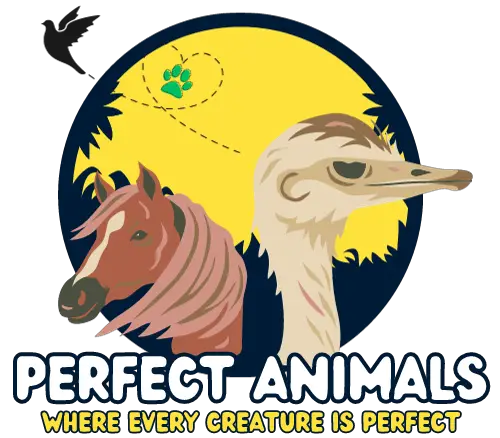Whiskers, also known as vibrissae, are specialized hairs protruding from the faces of many mammals.
They serve important sensory functions, acting as tactile organs that help animals navigate their environments and detect dangers or food sources.
Whiskers tend to be more abundant in nocturnal mammals that rely heavily on touch and sensation rather than eyesight for survival.
In this article, we will explore a range of different animals that are equipped with prominent whiskers.
From domestic pets like cats and dogs to wildlife like seals, walruses, and otters, whiskers provide essential sensory information to help regulate posture, gather spatial details, track prey movement, and more.
We will learn about how each animal utilizes its unique array of sensitive, sturdy whiskers.
Beyond just cosmetic facial features, whiskers offer remarkable benefits that improve animals’ ability to thrive.
Animals With Whiskers
Cats
Cats use their whiskers in remarkable ways that showcase the precise sensory capabilities of these facial features.
A cat’s whiskers are linked to nerves that respond to even minute changes in air pressure and airflow patterns.
With approximately 12 whiskers on each side of a cat’s muzzle, they collect a wealth of tactile information to help a cat gauge whether an opening is wide enough for its body to fit through.
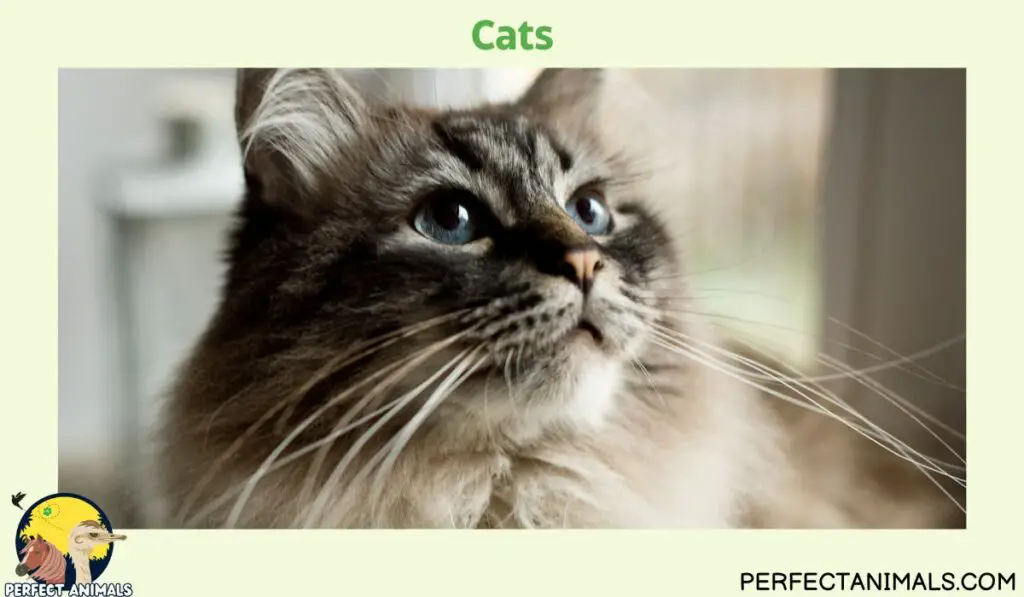
Whiskers also detect air currents, signaling a cat to change directions to stalk prey appropriately.
The whiskers above a cat’s eyes, called supraorbital whiskers, point forwards to detect object distances, allowing a cat to pounce with perfect timing.
A cat’s whiskers aid their impeccable balance and agility. Information about head and body positioning channels through whiskers to enable cats to land on their feet when falling.
Even whiskers on a cat’s rear legs help guide jumping and landing capacities. Beyond navigation and hunting benefits, whiskers also protect cats from threats or overwhelming stimuli.
Whiskers provide a distance buffer that cautions cats away from potential hazards to avoid harming their bodies.
An adaptable instrument for regulation, hunting, agility, and safety, a cat’s whisker positioning evolves intrinsically based on environmental conditions and demands.
You May Also Like – Animals With Curly Horns
Dogs
A dog relies on its whiskers almost like a human depends on sight.
Whiskers emerge from a series of nerves at the dog’s muzzle, upper lips, cheeks, and eyebrows to provide sensory input about the immediate physical environment.
Dogs have mobile whiskers that track back and forth to constantly gather updated tactile information.

The whiskers around the muzzle point slightly outward to maximally detect objects in front of the dog’s face.
Dogs especially depend on angular carpal whiskers on the forelegs to perceive surface textures and shapes when searching for objects with their paws.
A key purpose of a dog’s whiskers involves communicating head positioning relative to the body for optimal balance, movement, and spatial orientation.
Whiskers provide constant muscle and joint proprioception as a dog runs, jumps, or changes postures.
Canine whiskers are so sensitive that they can perceive minor airflow shifts.
When hunting prey in dense vegetation, whiskers pinpoint the exact site of quarry movements by detecting the slightest disturbances in the air.
Outside of physical navigation and hunting contexts, a dog’s facial whiskers also convey social and emotional messages to other canines.
Certain whisker positions and motions accompany play bows or aggressive warnings to clearly transmit friendly or defensive intentions.
Rabbits
As prey animals, rabbits rely heavily on whiskers to remain attentive to potential threats in their environments at all times.
Spotted across the entire rabbit face, prominent mystacial whiskers above the lips point downwards to sense ground textures for selecting optimal locations to dig burrows.
The upwards angled supraorbital whiskers gather constant overhead sightline data to detect aerial predators.
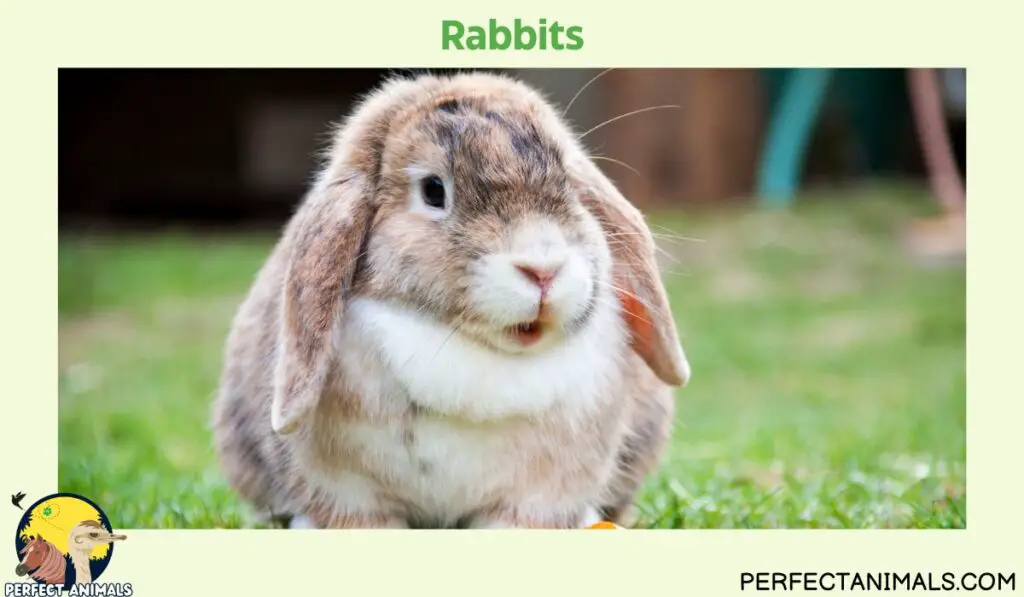
Rabbits also have specialized genal whiskers on their cheeks that perceive sideways motions to notice encroaching land hunters.
A rabbit’s whiskers provide vital information used to guide rapid evasive movements.
By sensing exact surroundings continuously, rabbits can dart away, zigzag unpredictably, or dive into burrows using split-second reaction times to avoid capture.
The blood supply to whiskers also signals emergency fear responses.
When rabbits sense grave danger, blood rushes to the whiskers first before the rest of the body prepares for urgent flight mode.
For timid, vulnerable rabbits, mobile whiskers that react before the eyes see threats provide an essential early warning system and directional guide used liberally for survival needs.
Related Article – 5 Types of Rabbits in Texas
Rats and Mice
As rodents, rats and mice rely on supremely sensitive whiskers all over their bodies to support movement through complex environments in low light.
Most prominently, stiff whiskers called mystacial vibrissae above the lip on each side of the muzzle provide essential spatial mapping and navigation information.
The mystacial whiskers connect to a large section of the brain, taking up processing power that underscores their importance for rats and mice.
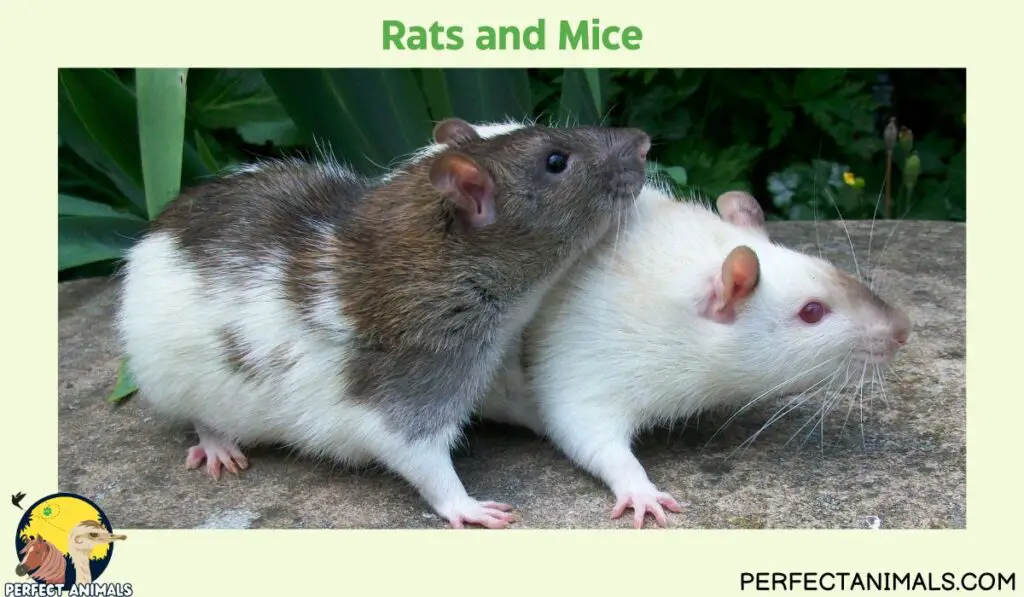
Rats and mice gather comprehensive tactile input through their whiskers to determine pathways for quick travel and identify holes or crevices to hide or store food in.
Whiskers carefully trace along vertical surfaces like walls to provide critical measurement details about openings.
On horizontal surfaces, rats’ and mice’s whiskers sweep back and forth rapidly to assemble textural maps used in mental positioning calculations during fast movement decisions.
Highly specialized follicle muscles surrounding each whisker even enable rats and mice to actively control specific whiskers for touch perception tasks.
By directing whisker movements, rats and mice hone sensory capabilities to support their incredulous plotting abilities.
Seals
Seals evolved with dense, robust whiskers encircling their snouts to provide essential tactile perception while hunting and navigating dark ocean waters.
Smooth-toothed species like harbor seals have the widest whisker set spacing to help trap fast-moving fish and other prey in salmon runs or schooling for survival needs.
The long tapered whiskers reach outside a seal’s visual field in a fan-like pattern to drastically expand sensory scope while swimming rapidly.

Whiskers guide seals by providing flow-detector capabilities underwater as well.
Tiny undulations along seal whiskers sense micro-turbulences, thermoclines, and pressure gradients within currents to establish positioning context while diving at ocean depths.
Seal whiskers even determine textures of rocky surfaces during dim passages through reefs or coastal caves while chasing food sources.
Equipped to procure meals in murky environments, seals deftly track whisker-derived spatial clues and hydrodynamic maps to successfully migrate long distances between productive feeding and breeding grounds seasonally.
Related Article – Do Seals Eat Penguins?
Walruses
As marine mammals, walruses rely profoundly on specialized whiskers given their limited vision capacity underwater.
Using stiff, accurately angled whiskers circling the entirety of the snout and lip area, walruses have an almost endless field of tactile perception surrounding their heads while diving.
This is crucial while finding shellfish and other prey tucked into rocky seabed cracks and crevices.
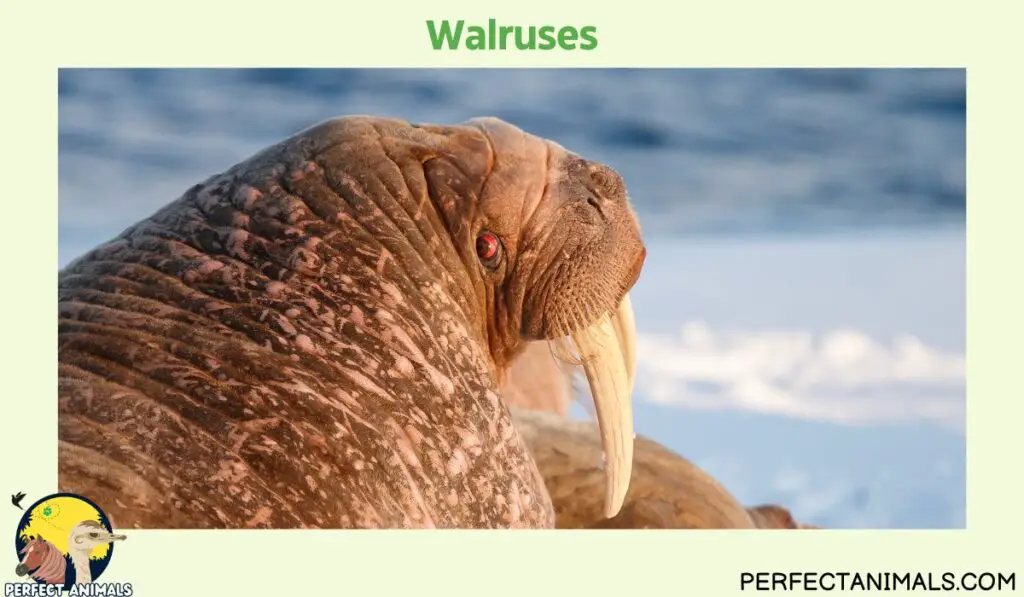
Walrus whiskers provide exact tactile shape and texture details to carefully identify food sources from a distance without visual input.
The upper section of sensitive walrus whiskers along the bridge of the snout and forehead also supplies critical social orientation cues.
Walruses use delicate whisker movements to signal recognition between pod members or mating displays showing interest when visual communication lacks efficacy underwater.
Prominent comparable to a mustache in male walruses, vertical specialized mystacial whiskers provide sexual maturity displays and convey aggressive mating rivalry warnings through precise positional patterns.
Beyond feeding and breeding displays, walruses also rely profoundly on overhead snout whiskers to detect breathing holes and maintain ice proximity without needing to surface fully from frigid Arctic waters.
Foxes
Foxes evolved as resourceful hunters superbly equipped with comprehensive whisker sensory capabilities guiding survival movements.
An expansive array of whiskers covers nearly the entire fox face to maximally gather environmental data.
Foxes have four signature long whiskers, called mystacial vibrissae, protruding at the upper lip to the side of the muzzle.

These exceptionally elongated whiskers lead fox navigation, functioning like antennae to create spatial maps constructed from tactile feedback.
When hunting small burrowing prey like rodents, foxes utilize their muzzle mystacial whiskers to establish underground tunnel positions.
Whiskers also catalog textural information about landscape features to optimize fox traversal through wooded or mountainous terrain during extensive roaming or prey pursuing.
An additional four shorter whiskers emerge above each fox eye socket in the supraorbital location, pointing forward to perceive immediate upcoming ground variations.
Along with chin whiskers gathering overhead data, foxes integrate continuous whisker-derived details about surroundings into advanced mental environmental frameworks supporting cunning behavior.
Related Article – Animals With No Natural Predators
Lions
As apex land predators hunting large fast prey across sweeping savannahs, lions require acutely precise spatial mapping abilities that whiskers amply provide.
A lion’s whiskers transfer tactile information about the slightest shifts in grass stems or airflow as herd animals dart erratically nearby.

Lions often begin hunts at dusk or night when vision lacks reliability, making whiskers essential to track prey movements by detecting disturbances in the background environment instead.
The Bold rich vibrissae filling out a male lion’s cheeks and muzzle significantly expand sensory scope to perceive prey animals from farther away through delicate pressure changes.
As lions rely profoundly on group hunting strategies, these advanced long-range prey detecting capabilities enable lions to signal pride members effectively.
Along with hunting benefits, a lion’s whiskers also provide balance support for epic powerful pouncing leaps used while catching robust swift antelope and zebra meals over sizeable distances.
Elephant Shrews
As tiny insectivores foraging through dense undergrowth across sub-Saharan Africa, elephant shrews use specialized whiskers to bolster inadequate vision given their low positioning close to the ground.
Elephant shrews have mystacial whiskers above the upper lip that stand perpendicular to the face to optimally detect and identify small prey items like ants, termites, beetles, and moths buried in leaf litter as they move with high speeds low to the ground.
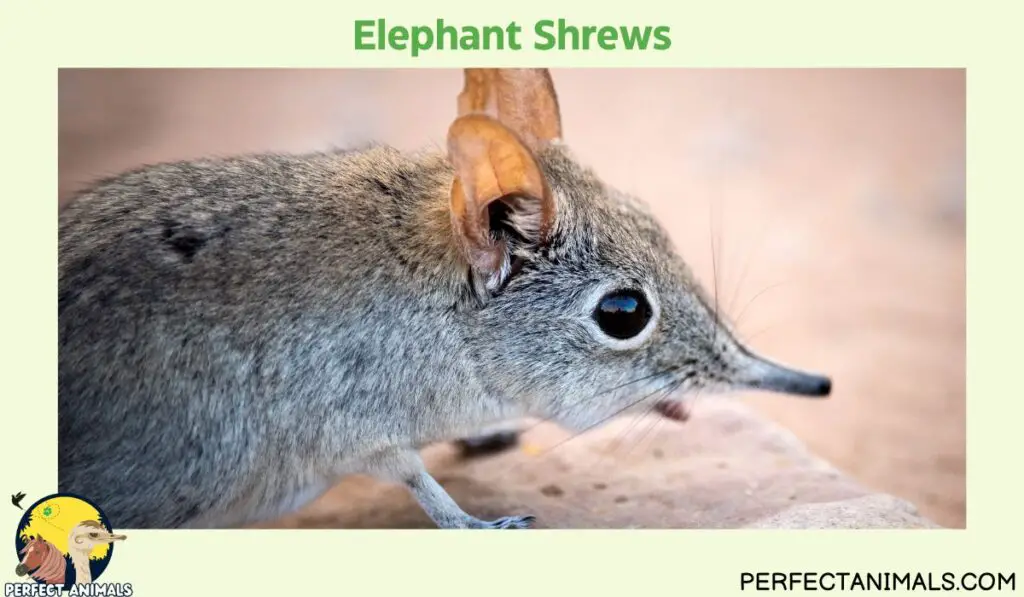
The whiskers connect to large sensory regions of elephant shrews’ brains, underscoring their importance for supplying food source and obstacle positions during rapid movement.
Elephant shrews also have thick genal vibrissae whiskers along the cheeks that orient sideways to perceive approaching threats from lizards or predatory birds through sensitive pressure changes.
Equipped with disproportionately long tactile hairs assessing surroundings compared to their miniature bodies, elephant shrew whiskers enable efficient high success rate feeding and effective escape behaviors to aid resilience.
You May Also Like – Are Hyenas Dogs or Cats?
Beavers
As prolific woodworking rodents inhabiting river ecosystems, beavers rely profoundly on specialized whiskers to accomplish remarkable construction feats both underwater and on land.
Prominent stiff leathery whiskers around a beaver’s mouth provide essential tactile feedback while gathering woody vegetation for impressive dams and lodges shielding home territories from threats and frigid winters.
Beaver whiskers adeptly assess diameters and textures of logs or branches hauled through murky waters back to infrastructure job sites.
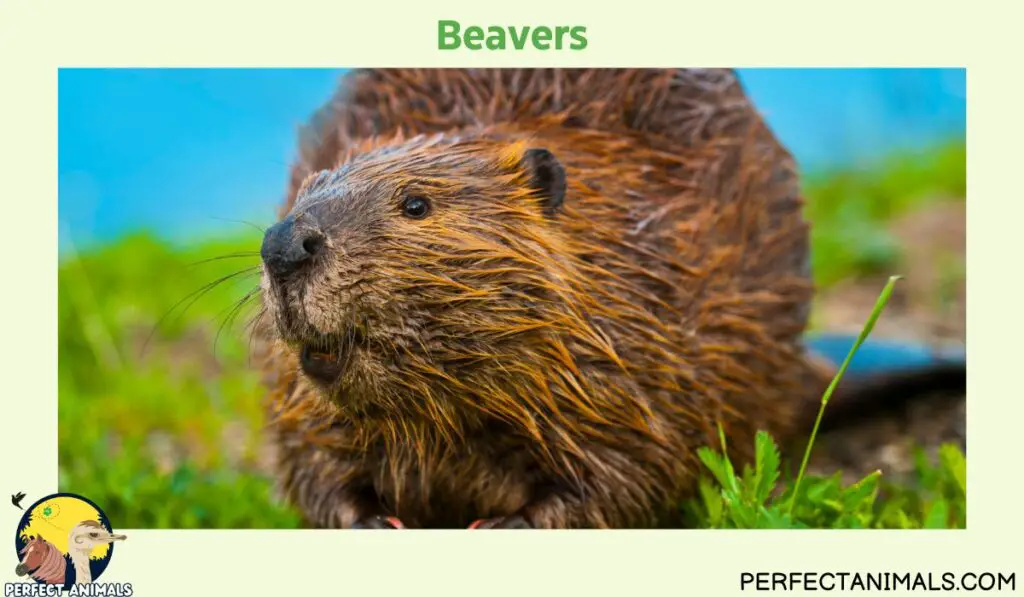
Beavers have elongated upper lip whiskers that orient slightly outward from their faces for maximally scanning wide tactile fields in front of them while swimming.
Additionally, beaver whiskers extending along cheeks to nearly the rear of heads gather extensive spatial details ensuring successful navigation through winding den doorways and canals during lodge interior and underwater maintenance activities performed daily.
Highly sensitive trigeminal nerves conveying extensive touch signals from abundantly distributed beaver whiskers to the brain underscore their invaluable role providing spatial, structural, and navigational frameworks utilized during remarkable teeth-carving construction ingenuity.
Otters
Sleek semiaquatic hunters, otters are equipped with specialized whiskers providing essential tactile guidance while diving to catch slippery prey and traverse through dim, dense spaces.
Notably, otters have exceptionally sensitive whiskers on the upper bridge of the muzzle pointing slightly outward to vastly extend sensory reach underwater when chasing fast fish or crustaceans into obscure rocky holes and crevices.
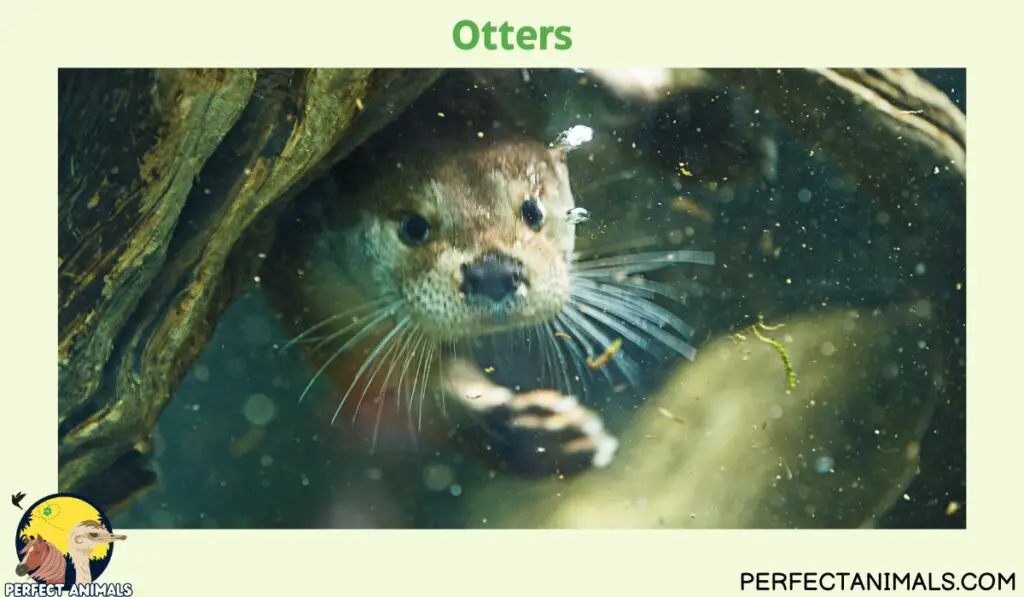
Otters adeptly maneuver through chaotic wave surges near coastal areas or tightly wound mangrove thickets while hunting by relying profoundly on rapid whisker interpretations rather than inefficient vision given particulate-heavy saltwater environments.
Otters also have shorter macrovibrissae and microvibrissae whiskers on their chin and just above the mouth that supply crucial positional signals during hunting dives and food item handling once caught.
While consuming meals, otter upper lip whiskers orient outward to continue scanning surroundings for potential threats.
Equipped with prominent mystacial whiskers almost mimicking a mustache along with lower chin whisker arrays, otters can thrive as fierce river predators while adapting to challenging marine foraging contexts requiring broad tactile dexterity.
You May Also Like – 18 Amazing Animals With Long Necks
Raccoons
As resourceful foragers inclined to thrive near humans across a sweeping range of habitats, raccoons utilize whiskers in clever ways matching their innate curiosity and perseverance.
Dense whiskers extending along the entire length of the raccoon snout provide a precise touch perception apparatus used while probing, rolling, digging, or pulling apart objects when scavenging for foods.

Sharp whiskers supply measurement details about the size and shape compatibility of trash items, storm drain openings, chimneys, or hollow logs inspected thoroughly by driven raccoons during nightly troves through urban and wooded areas alike.
Raccoon paws have specialized carpal whiskers emerging beside toes to meticulously catalog textures and identify objects by touch alone, which aids their hand dexterity exhibited when manipulating all manner of containers to access leftovers, plants or invertebrates comprising varied diets.
Baby raccoons rely extensively on facial and forepaw whiskers while learning complex motor activities like descending treetrunks front-facing or cracking hard-shelled nuts and invertebrates open.
Equipped with highly responsive tactile hairs in key locations that substitute vision, particularly at night, versatile raccoon whiskers provide orientation frameworks supporting success across diverse if not outright hazardous foraging grounds.
Final Thoughts
Whiskers reveal far more than we ever imagined about how mammals perceive the world and master survival challenges.
From pets we adore like cats and dogs to iconic wildlife species, whiskers provide an evolutionary sensory advantage that substitutes vision with precise tactile guidance.
As we explored across mammals ranging from tiny elephant shrews to mighty lions and walruses, whiskers supply spatial maps constructed through delicate touch interpretations that direct movement, communicate intentions, gather prey details, and assess threats.
Whiskers transform with specialized length, width, follicle muscles, nerve connections matching animals’ navigation and hunting contexts from underground tunnels to open oceans.
While we may first notice a cat or rabbit’s prominent whiskers as cosmetic facial features, their profound impacts on orientation, environmental comprehension, social bonds and resilience shine through.
Whiskers enable mammals to thrive despite vision limitations or challenging habitats based on impeccable somatosensory foundations.
Beyond just furry adornments, whiskers illustrate the ingenious ways mammals transformed touch into an indispensable survival apparatus through innovative whisker placement and sensitivity.
Resources – (for further reading)
Wikipedia – Whiskers
Study.com – Why Do Dogs & Cats Have Whiskers? | Overview & Function

Sarah has years of experience working as a zookeeper. She has cared for a wide variety of animals, from primates to big cats. Her passion for animals extends beyond her profession, as she dedicates her free time to writing about wildlife and their conservation.
